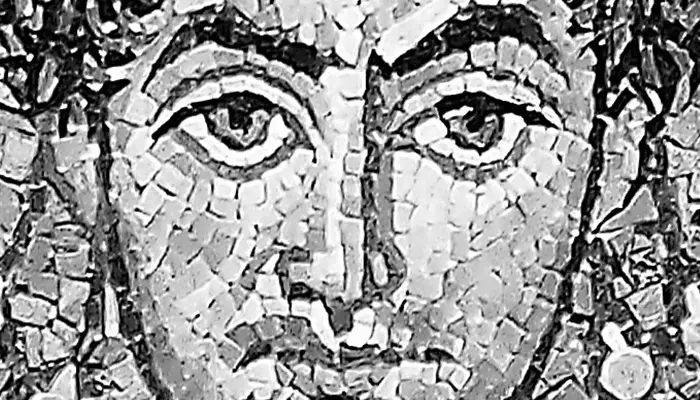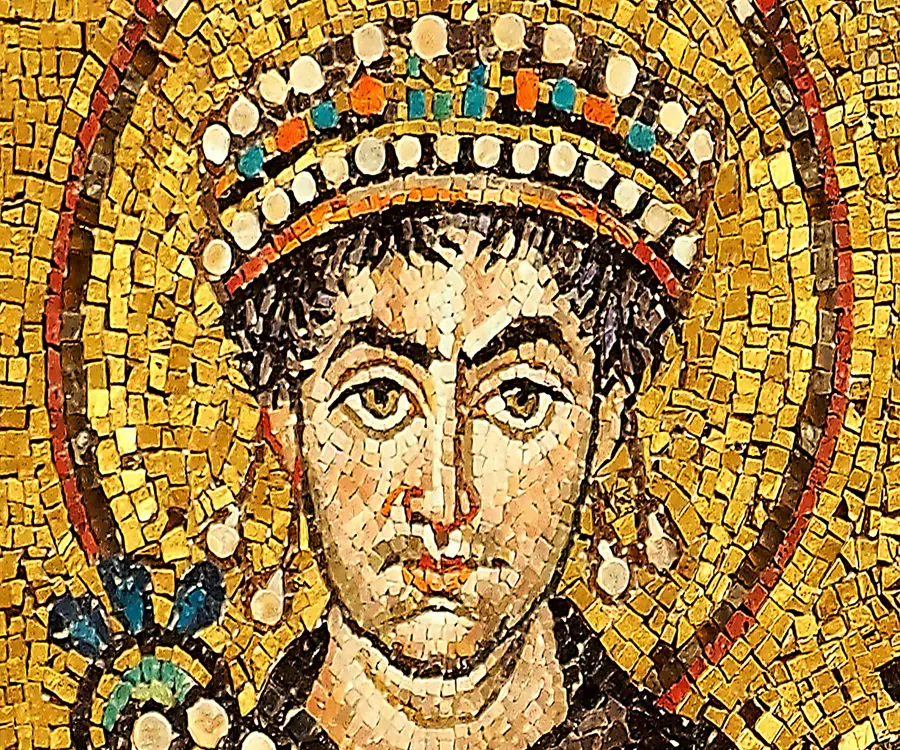
Justinian I - Emperors, Timeline and Family
Justinian I's Personal Details
Justinian I, also known as ‘Justinian the Great’ and ‘Saint Justinian the Great’, was a Byzantine (East Roman) Emperor
| Information | Detail |
|---|---|
| Birthday | 482 |
| Died on | November 14, 565 |
| Nationality | Macedonian |
| Famous | Historical Personalities, Emperors & Kings, Byzantine Emperor, Emperors, Kings |
| Spouses | Theodora |
| Known as | Justinian the Great, Saint Justinian the Great, Petrus Sabbatius (until ascension) Flavius Petrus Sabbatius Iustinianus Augustus (as emperor) |
| Childrens | Theodora |
| Birth Place | Tauresium, Dardania, then part of Diocese of Dacia (in today's Republic of Macedonia |
| Gender | Male |
| Father | Sabbatius, Justin I (adoptive) |
| Mother | Vigilantia |
| Born in | Tauresium, Dardania, then part of Diocese of Dacia (in today's Republic of Macedonia |
| Famous as | Byzantine Emperor |
| Died at Age | 83 |
Justinian I's photo
Who is Justinian I?
Justinian I, also known as ‘Justinian the Great’ and ‘Saint Justinian the Great’, was a Byzantine (East Roman) Emperor and one of the most influential rulers in the western history. At the time he acquired the throne, the kingdom was weak and Justinian vowed to make it powerful again and rightly so, he set out to reclaim the western half of the empire and successfully won it. His reign is also known famously in the history as the ‘restoration of the Empire’. In his important campaigns, he took Africa back from the Vandals and defeated Goths to make Italy a part of his empire again. He also set out to build countless new churches, monasteries, forts, water reservoirs and bridges. The public loved him as much as it feared him. One of the other biggest achievements of his reign was his decision to order the rewriting of Roman law, called Corpus Juris Civilis. These documents were so modern in their nature that many of the modern civil laws take their inspiration from it.
// Famous Kings
Sundiata Keita
Sundiata Keita was the founder of the Mali Empire in West Africa. This biography profiles his childhood, early life, struggles, founding of empire, rule, administration, achievements and also gives some fun facts.
Ashoka
Ashoka was the third emperor of the Mauryan Dynasty and ruled almost the entire Indian subcontinent. This biography profiles his childhood, life, reign, achievements and timeline
Murad IV
Murad IV was one of the mighty Sultans in the history of the Ottoman Empire. This biography profiles his childhood, family, accession, rule, administration and timeline.
Childhood & Early Life
Most of the details about the early life of Justinian I got lost in the course of history but the sources say that he was born in 482 BC. He hailed from a peasant family, but his uncle, Justin, held an important place in the royal court as the imperial guard (the excubitors) and later became the emperor. Justin brought little Justinian with him to the royal city of Constantinople to take care of his education and as a result, Justinian received high level education from the best teachers in the world in subjects like Roman History and Theology. Some claim that he was short, a little chubby, fair and handsome young man who had a flair for reading and would read every other book which came his way.
In the year 518, when the Roman emperor Anastasius died without having any heir, Justin was made the emperor. Justinian was a well educated young man and was almost sure to be named the heir to the throne. His uncle put all his faith in him and considering the fact that Justinian was a well educated young man, King Justin always asked his advice in all important matters. There came a time, when Justinian actually ruled the empire, while Justin was just an old man sitting on the throne and when King Justin died in August 527, Justinian was named the ruler.
Accession & Reign
In the early stages of his reign, Justinian I worked so much that he became famous as the ‘Emperor who never sleeps’ and in 525, he married Theodora, a girl from the lower class. Although he faced a certain backlash from his people but he told them that the king Justin had abolished the class system from the Empire. Theodora proved to be a great woman and supported her husband in all the important matters of the court.
Around 528, Justinian began his military campaigns to strengthen the weakening Roman Empire and by then, his tax ministers had applied some great tax reforms, which provided the king with enough finances to fund his military expeditions. His general Belisarius set out to fight the Persians around 528, but lost. The war with Persians stretched long and in the second battle in 530 which was fought at Daras, the roman army emerged victorious, only to lose again a year later at Euphrates and eventually, the king was forced to sign a peace treaty with the Persians.
General Belisarius advised the king to reclaim the lost lands in Africa and Italy. The Vandals and Gothic invasions had snatched them from the Romans sometime back and Justinian had vowed to take them back, in order to re-establish the Roman Empire as the greatest one in the world yet again. In 533, Belisarius set out with a great army and 500 ships. The Vandals in Africa were crushed and their ruler was taken prisoner, and once again, African continent came under the authority of Romans.
In 535, Justinian focussed towards Italy, which was under a very weak rule and a usurper was sitting on the throne while kidnapping the royal queen. This unrest provided Belisarius with a great chance to invade and bring Italy under Justinian’s rule. Somehow, the Gothic rulers by then had retaken the Italian throne and the Gothic ruler Vitigis was named the new king and he gathered an army strong enough to halt Belisarius. Justinian had to send another general with more force and finally after years of constant battles and turmoil, Italy was captured in 540.
However, it wasn’t over for the Goths, as they rose from obscurity once again in 542 and reclaimed many south Italian cities from Justinian. Somehow, Justinian was tired of Goths for their stubbornness and sent a major troop consisting of about 35000 men and a new general named Narses, and finally in 552, at the battle of Busta Gallorum and in 554 in Casilinum, the decisive battle was fought and Italy came under Byzantium rule for good.
In pursuit of extending the Roman Empire, Justinian had used up too much manpower and wealth of the crown and general public condemned him as the taxes were raised as a result. But despite that, there were many who believed in him and his policies.
Justinian oversaw the construction of many churches, temples, forts and other establishments for the ease of his public, and for that sole reason, he remained a loved ruler all his life for half of the population.
But as it is the case with most of the greatest empires, there were many in the empire who opposed him. In 529, Julianus ben Sabar, a major religious figure in Palestine, revolted against the king by taking help of some Samaritan people. And worse, in 532, the Niko riots took place, which took the lives of almost 10 thousand people in the city of Constantinople alone. This left most parts of the city ruined and the other Samaritan revolt, which occurred in 559, didn’t stop until the death of Justinian.
Ever since he became the emperor, Justinian always wanted to bring all the laws, legal system notes and commentaries under one document, which would act as standard law throughout the empire. He hired Tribonian to do the job for him and finally, Codex Justinianus published its very first text in the year 534. The second edition of the text is still present today and gives a solid glimpse of the effective way the ancient Roman empires handled their law and order machinery.
Final Days & Legacy
Even though he was hailed as one of the best roman emperors after his death, he wasn’t as much popular when he lived. Nika riots almost snatched his throne away from him and the wars he fought in Africa and Italy burdened the general public with taxes which could have been avoided if the tax ministers of Justinian I were a bit more efficient. Even though all this hate didn’t affect Justinian in the early days of his reign, he slowly started taking all the hatred to his heart.
His loving wife Theodora had also become notorious as a rumoured nymphomaniac and it was said that she had physical relations with many of the royal courtesans in Justinian’s court. Later in his life in the year 562, Justinian also found out that many loyal servants of the crown had conspired to kill him back during the Nika riots. He suffered from plague in 540 once, which although didn’t kill him but made him extremely weak physically and emotionally and worse, his wife Theodora died in 548 due to cancer.
Somehow, Justinian got fed up with all the games and planned his retirement in the early 560s. The accounts of his life say that he became a very religious man during his last few days and finally died in November 565. His personal life was sad, he left no children behind. Although Theodora gave birth to a son early after the marriage, the foetus died and after that, Theodora never got pregnant. Justin II, the son of Justinian’s sister Vigilantia sat on the throne after the demise of Justinian. His body was placed in the specially built mausoleum at Church of the Holy Apostles.
Depictions
In ‘The Divine Comedy’ by Dante, Justinian I got portrayed comically as a spirit sitting on Mercury. Pierson Dixon wrote a book in 1958 about the happenings of Justinian’s court titled ‘The Glittering Horn: Secret Memoirs of the Court of Justinian’.
// Famous Emperors
Sundiata Keita
Sundiata Keita was the founder of the Mali Empire in West Africa. This biography profiles his childhood, early life, struggles, founding of empire, rule, administration, achievements and also gives some fun facts.
Ashoka
Ashoka was the third emperor of the Mauryan Dynasty and ruled almost the entire Indian subcontinent. This biography profiles his childhood, life, reign, achievements and timeline
Murad IV
Murad IV was one of the mighty Sultans in the history of the Ottoman Empire. This biography profiles his childhood, family, accession, rule, administration and timeline.
Justinian I biography timelines
- // 1958In ‘The Divine Comedy’ by Dante, Justinian I got portrayed comically as a spirit sitting on Mercury. Pierson Dixon wrote a book in 1958 about the happenings of Justinian’s court titled ‘The Glittering Horn: Secret Memoirs of the Court of Justinian’.
// Famous Emperors & Kings
Sundiata Keita
Sundiata Keita was the founder of the Mali Empire in West Africa. This biography profiles his childhood, early life, struggles, founding of empire, rule, administration, achievements and also gives some fun facts.
Ashoka
Ashoka was the third emperor of the Mauryan Dynasty and ruled almost the entire Indian subcontinent. This biography profiles his childhood, life, reign, achievements and timeline
Murad IV
Murad IV was one of the mighty Sultans in the history of the Ottoman Empire. This biography profiles his childhood, family, accession, rule, administration and timeline.
Xerxes I
Xerxes I (Xerxes the Great) was the fourth and the most famous king of the Archaemenid dynasty of Persia. This biography profiles his childhood, family, personal life, life history, achievements, campaigns, administration, death and other facts.
Sargon of Akkad
Sargon of Akkad, also called ‘Sargon the Great’, ‘Sarru-Kan’ and ‘Shar-Gani-Sharri’, was the founder and first king of the Akkadian Empire. This biography profiles his childhood, life, rule, administration, timeline, and gives some fun facts.
Abdullah of Saudi Arabia
Abdullah bin Abdulaziz Al Saud was the King of Saudi Arabia from 2005 to 2015 and the third wealthiest head of state in the world. Find more facts about his life, childhood and timeline.
Justinian I's FAQ
When was Justinian I died?
Justinian I was died at 0565-11-14
Which age was Justinian I died?
Justinian I was died at age 83
Where is Justinian I's birth place?
Justinian I was born in Tauresium, Dardania, then part of Diocese of Dacia (in today's Republic of Macedonia
What is Justinian I nationalities?
Justinian I's nationalities is Macedonian
Who is Justinian I spouses?
Justinian I's spouses is Theodora
Who is Justinian I childrens?
Justinian I's childrens is Theodora
Who is Justinian I's father?
Justinian I's father is Sabbatius, Justin I (adoptive)
Who is Justinian I's mother?
Justinian I's mother is Vigilantia
How famous is Justinian I?
Justinian I is famouse as Byzantine Emperor






